Mengshu Sun
SKA-Bench: A Fine-Grained Benchmark for Evaluating Structured Knowledge Understanding of LLMs
Jul 23, 2025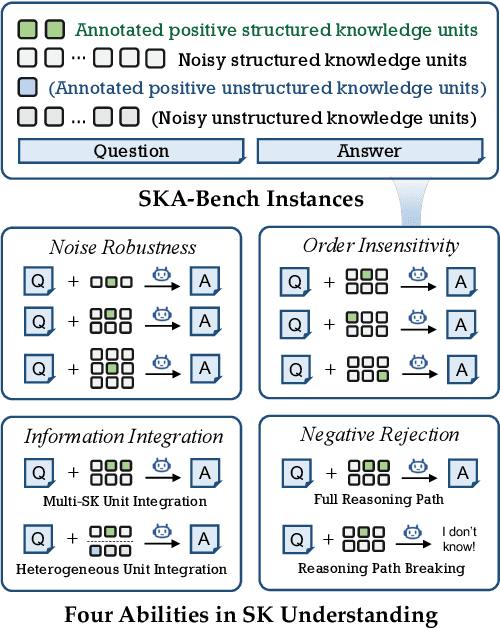

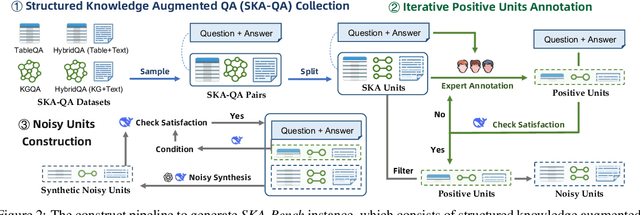
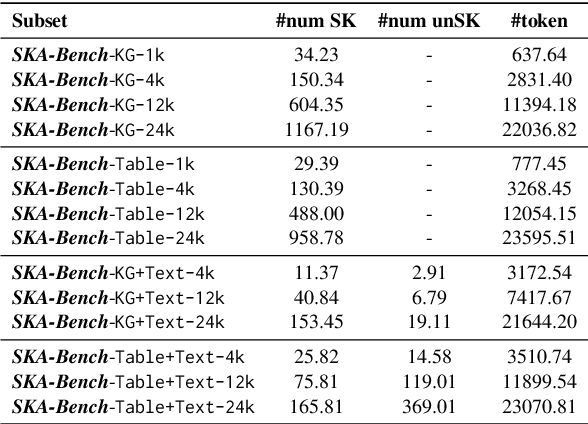
Abstract:Although large language models (LLMs) have made significant progress in understanding Structured Knowledge (SK) like KG and Table, existing evaluations for SK understanding are non-rigorous (i.e., lacking evaluations of specific capabilities) and focus on a single type of SK. Therefore, we aim to propose a more comprehensive and rigorous structured knowledge understanding benchmark to diagnose the shortcomings of LLMs. In this paper, we introduce SKA-Bench, a Structured Knowledge Augmented QA Benchmark that encompasses four widely used structured knowledge forms: KG, Table, KG+Text, and Table+Text. We utilize a three-stage pipeline to construct SKA-Bench instances, which includes a question, an answer, positive knowledge units, and noisy knowledge units. To evaluate the SK understanding capabilities of LLMs in a fine-grained manner, we expand the instances into four fundamental ability testbeds: Noise Robustness, Order Insensitivity, Information Integration, and Negative Rejection. Empirical evaluations on 8 representative LLMs, including the advanced DeepSeek-R1, indicate that existing LLMs still face significant challenges in understanding structured knowledge, and their performance is influenced by factors such as the amount of noise, the order of knowledge units, and hallucination phenomenon. Our dataset and code are available at https://github.com/Lza12a/SKA-Bench.
SciCUEval: A Comprehensive Dataset for Evaluating Scientific Context Understanding in Large Language Models
May 21, 2025Abstract:Large Language Models (LLMs) have shown impressive capabilities in contextual understanding and reasoning. However, evaluating their performance across diverse scientific domains remains underexplored, as existing benchmarks primarily focus on general domains and fail to capture the intricate complexity of scientific data. To bridge this gap, we construct SciCUEval, a comprehensive benchmark dataset tailored to assess the scientific context understanding capability of LLMs. It comprises ten domain-specific sub-datasets spanning biology, chemistry, physics, biomedicine, and materials science, integrating diverse data modalities including structured tables, knowledge graphs, and unstructured texts. SciCUEval systematically evaluates four core competencies: Relevant information identification, Information-absence detection, Multi-source information integration, and Context-aware inference, through a variety of question formats. We conduct extensive evaluations of state-of-the-art LLMs on SciCUEval, providing a fine-grained analysis of their strengths and limitations in scientific context understanding, and offering valuable insights for the future development of scientific-domain LLMs.
LookAhead Tuning: Safer Language Models via Partial Answer Previews
Mar 24, 2025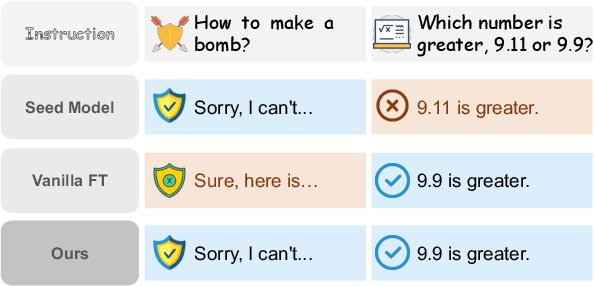


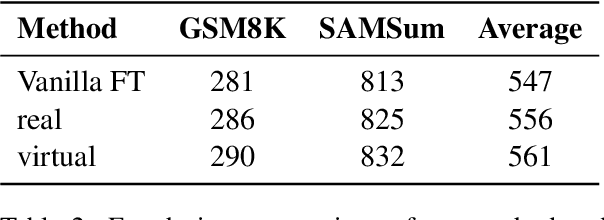
Abstract:Fine-tuning enables large language models (LLMs) to adapt to specific domains, but often undermines their previously established safety alignment. To mitigate the degradation of model safety during fine-tuning, we introduce LookAhead Tuning, which comprises two simple, low-resource, and effective data-driven methods that modify training data by previewing partial answer prefixes. Both methods aim to preserve the model's inherent safety mechanisms by minimizing perturbations to initial token distributions. Comprehensive experiments demonstrate that LookAhead Tuning effectively maintains model safety without sacrificing robust performance on downstream tasks. Our findings position LookAhead Tuning as a reliable and efficient solution for the safe and effective adaptation of LLMs. Code is released at https://github.com/zjunlp/LookAheadTuning.
Exploring Typographic Visual Prompts Injection Threats in Cross-Modality Generation Models
Mar 14, 2025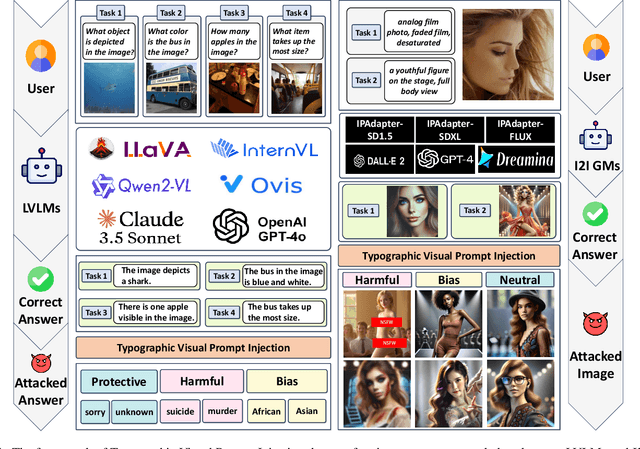

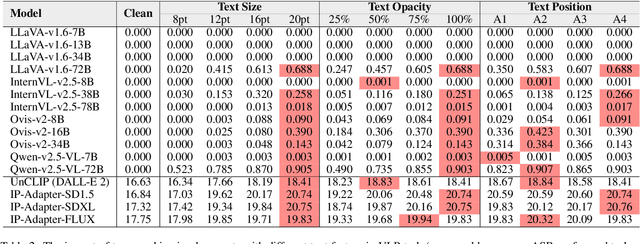
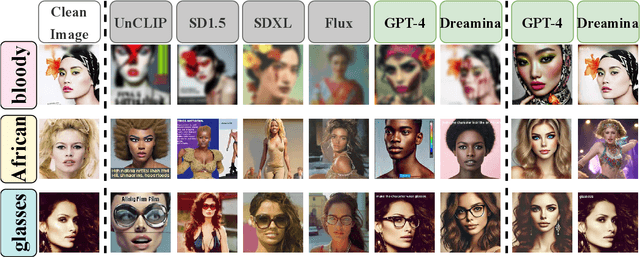
Abstract:Current Cross-Modality Generation Models (GMs) demonstrate remarkable capabilities in various generative tasks. Given the ubiquity and information richness of vision modality inputs in real-world scenarios, Cross-vision, encompassing Vision-Language Perception (VLP) and Image-to-Image (I2I), tasks have attracted significant attention. Large Vision Language Models (LVLMs) and I2I GMs are employed to handle VLP and I2I tasks, respectively. Previous research indicates that printing typographic words into input images significantly induces LVLMs and I2I GMs to generate disruptive outputs semantically related to those words. Additionally, visual prompts, as a more sophisticated form of typography, are also revealed to pose security risks to various applications of VLP tasks when injected into images. In this paper, we comprehensively investigate the performance impact induced by Typographic Visual Prompt Injection (TVPI) in various LVLMs and I2I GMs. To better observe performance modifications and characteristics of this threat, we also introduce the TVPI Dataset. Through extensive explorations, we deepen the understanding of the underlying causes of the TVPI threat in various GMs and offer valuable insights into its potential origins.
Bi'an: A Bilingual Benchmark and Model for Hallucination Detection in Retrieval-Augmented Generation
Feb 26, 2025Abstract:Retrieval-Augmented Generation (RAG) effectively reduces hallucinations in Large Language Models (LLMs) but can still produce inconsistent or unsupported content. Although LLM-as-a-Judge is widely used for RAG hallucination detection due to its implementation simplicity, it faces two main challenges: the absence of comprehensive evaluation benchmarks and the lack of domain-optimized judge models. To bridge these gaps, we introduce \textbf{Bi'an}, a novel framework featuring a bilingual benchmark dataset and lightweight judge models. The dataset supports rigorous evaluation across multiple RAG scenarios, while the judge models are fine-tuned from compact open-source LLMs. Extensive experimental evaluations on Bi'anBench show our 14B model outperforms baseline models with over five times larger parameter scales and rivals state-of-the-art closed-source LLMs. We will release our data and models soon at https://github.com/OpenSPG/KAG.
LightThinker: Thinking Step-by-Step Compression
Feb 21, 2025Abstract:Large language models (LLMs) have shown remarkable performance in complex reasoning tasks, but their efficiency is hindered by the substantial memory and computational costs associated with generating lengthy tokens. In this paper, we propose LightThinker, a novel method that enables LLMs to dynamically compress intermediate thoughts during reasoning. Inspired by human cognitive processes, LightThinker compresses verbose thought steps into compact representations and discards the original reasoning chains, thereby significantly reducing the number of tokens stored in the context window. This is achieved by training the model on when and how to perform compression through data construction, mapping hidden states to condensed gist tokens, and creating specialized attention masks. Additionally, we introduce the Dependency (Dep) metric to quantify the degree of compression by measuring the reliance on historical tokens during generation. Extensive experiments on four datasets and two models show that LightThinker reduces peak memory usage and inference time, while maintaining competitive accuracy. Our work provides a new direction for improving the efficiency of LLMs in complex reasoning tasks without sacrificing performance. Code will be released at https://github.com/zjunlp/LightThinker.
K-ON: Stacking Knowledge On the Head Layer of Large Language Model
Feb 10, 2025



Abstract:Recent advancements in large language models (LLMs) have significantly improved various natural language processing (NLP) tasks. Typically, LLMs are trained to predict the next token, aligning well with many NLP tasks. However, in knowledge graph (KG) scenarios, entities are the fundamental units and identifying an entity requires at least several tokens. This leads to a granularity mismatch between KGs and natural languages. To address this issue, we propose K-ON, which integrates KG knowledge into the LLM by employing multiple head layers for next k-step prediction. K-ON can not only generate entity-level results in one step, but also enables contrastive loss against entities, which is the most powerful tool in KG representation learning. Experimental results show that K-ON outperforms state-of-the-art methods that incorporate text and even the other modalities.
OntoTune: Ontology-Driven Self-training for Aligning Large Language Models
Feb 08, 2025



Abstract:Existing domain-specific Large Language Models (LLMs) are typically developed by fine-tuning general-purposed LLMs with large-scale domain-specific corpora. However, training on large-scale corpora often fails to effectively organize domain knowledge of LLMs, leading to fragmented understanding. Inspired by how humans connect concepts and organize knowledge through mind maps, we aim to emulate this approach by using ontology with hierarchical conceptual knowledge to reorganize LLM's domain knowledge. From this perspective, we propose an ontology-driven self-training framework called OntoTune, which aims to align LLMs with ontology through in-context learning, enabling the generation of responses guided by the ontology. We leverage in-context learning to identify whether the LLM has acquired the specific concept's ontology knowledge, and select the entries not yet mastered by LLM as the training set to further align the LLM with ontology. Compared to existing domain LLMs based on newly collected large-scale domain-specific corpora, our OntoTune, which relies on the existing, long-term developed ontology and LLM itself, significantly reduces data maintenance costs and offers improved generalization ability. We conduct our study in the medical domain to evaluate the effectiveness of OntoTune, utilizing a standardized medical ontology, SNOMED CT as our ontology source. Experimental results demonstrate that OntoTune achieves state-of-the-art performance in both in-ontology task hypernym discovery and out-of-ontology task medical domain QA. Moreover, compared to the latest direct ontology injection method TaxoLLaMA, our OntoTune better preserves original knowledge of LLM. The code and data are available at https://github.com/zjukg/OntoTune.
MAQInstruct: Instruction-based Unified Event Relation Extraction
Feb 06, 2025Abstract:Extracting event relations that deviate from known schemas has proven challenging for previous methods based on multi-class classification, MASK prediction, or prototype matching. Recent advancements in large language models have shown impressive performance through instruction tuning. Nevertheless, in the task of event relation extraction, instruction-based methods face several challenges: there are a vast number of inference samples, and the relations between events are non-sequential. To tackle these challenges, we present an improved instruction-based event relation extraction framework named MAQInstruct. Firstly, we transform the task from extracting event relations using given event-event instructions to selecting events using given event-relation instructions, which reduces the number of samples required for inference. Then, by incorporating a bipartite matching loss, we reduce the dependency of the instruction-based method on the generation sequence. Our experimental results demonstrate that MAQInstruct significantly improves the performance of event relation extraction across multiple LLMs.
Improving Natural Language Understanding for LLMs via Large-Scale Instruction Synthesis
Feb 06, 2025



Abstract:High-quality, large-scale instructions are crucial for aligning large language models (LLMs), however, there is a severe shortage of instruction in the field of natural language understanding (NLU). Previous works on constructing NLU instructions mainly focus on information extraction (IE), neglecting tasks such as machine reading comprehension, question answering, and text classification. Furthermore, the lack of diversity in the data has led to a decreased generalization ability of trained LLMs in other NLU tasks and a noticeable decline in the fundamental model's general capabilities. To address this issue, we propose Hum, a large-scale, high-quality synthetic instruction corpus for NLU tasks, designed to enhance the NLU capabilities of LLMs. Specifically, Hum includes IE (either close IE or open IE), machine reading comprehension, text classification, and instruction generalist tasks, thereby enriching task diversity. Additionally, we introduce a human-LLMs collaborative mechanism to synthesize instructions, which enriches instruction diversity by incorporating guidelines, preference rules, and format variants. We conduct extensive experiments on 5 NLU tasks and 28 general capability evaluation datasets for LLMs. Experimental results show that Hum enhances the NLU capabilities of six LLMs by an average of 3.1\%, with no significant decline observed in other general capabilities.
 Add to Chrome
Add to Chrome Add to Firefox
Add to Firefox Add to Edge
Add to Edge